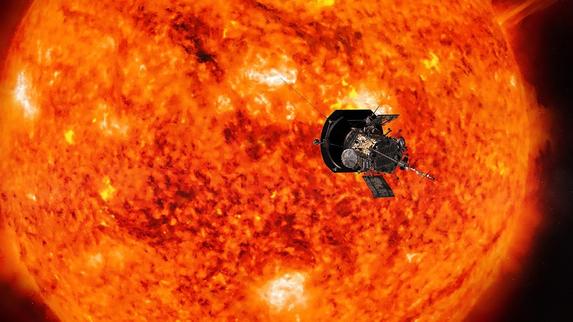 This handout illustration obtained July 6, 2018 courtesy of NASA/Johns Hopkins APL shows an artist’s conception of NASA’s Parker Solar Probe, the spacecraft that will fly through the Sun’s corona to trace how energy and heat move through the star’s atmosphere.(PHOTO / AFP)
This handout illustration obtained July 6, 2018 courtesy of NASA/Johns Hopkins APL shows an artist’s conception of NASA’s Parker Solar Probe, the spacecraft that will fly through the Sun’s corona to trace how energy and heat move through the star’s atmosphere.(PHOTO / AFP)
NANJING - China's first solar probe, Advanced Space-based Solar Observatory (ASO-S), is scheduled to be launched into space in the first half of 2022, marking the country's first-ever mission to "touch" the sun.
The satellite will operate in a sun-synchronous orbit 720 km above Earth to keep a close tab on the sun 24 hours a day. Measuring about 1,000 kg in total mass, the satellite is expected to orbit the sun for at least four years, according to the Purple Mountain Observatory of the Chinese Academy of Sciences, a research institute based in Nanjing, east China's Jiangsu province.
The main scientific objectives of the probe include observing the sun's magnetic field and two major eruptive phenomena, or bursts on the star, that are solar flares and coronal mass ejections
The main scientific objectives of the probe include observing the sun's magnetic field and two major eruptive phenomena, or bursts on the star, that are solar flares and coronal mass ejections (CMEs). It will deploy three payloads, including Full disk Vector MagnetoGraph, Hard X-ray Imager, and Lyman-alpha Solar Telescope.
READ MORE: Australia fast-tracks US$16b solar power export project
Hitherto the sun is the only fixed star that can be studied in detail by humans. The vast majority of its radiation is blocked by Earth's atmosphere. Only by sending probes into space can a complete picture of the sun be presented for further studies.
As the sun's temper varies on an 11-year cycle and the star enters Solar Cycle 25, it is estimated to reach its peak radiation around 2025. The solar probe can help obtain detailed records of solar activity during its rise to the peak years, said Gan Weiqun, a researcher with the institute.
The satellite will also realize its potential in space weather forecasting. The CMEs can be detected at least 40 hours ahead of their arrival by the observatory, which is expected to further facilitate early warnings of damage to Earth's electromagnetic environment.
ALSO READ: Powering the world with solar boost
Since the 1960s, more than 70 satellites related to solar observation have been launched globally. The ASO-S is expected to plug China's gap in the field, according to Gan.


